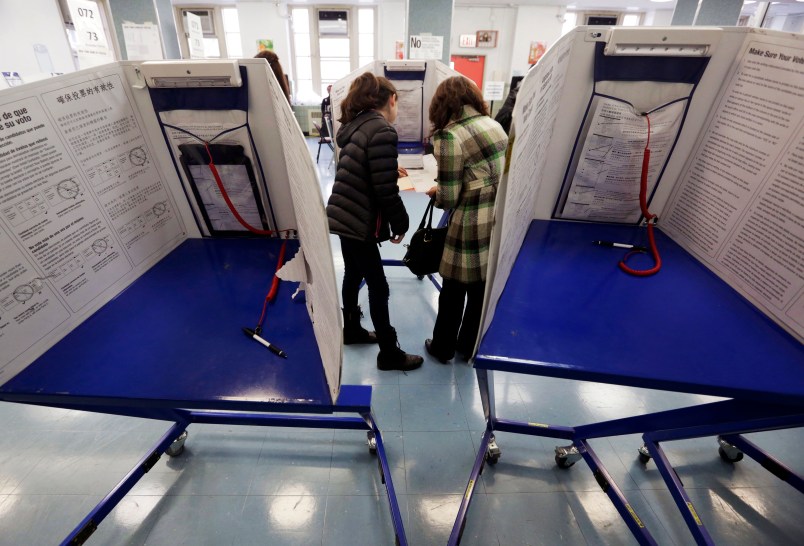At some point in 2014, many members of the punditocracy will tire of writing about the same handful of competitive congressional seats and notice elections are occurring in the several states. Let’s give them a head start, because the dynamics of gubernatorial and legislative races this year are a bit of a fascinating mystery.
In theory, Republicans should be exposed to some serious losses thanks to their 2010 landslide. They will defend 22 of the 36 governorships up this November. Nine are in states carried twice by Barack Obama. Republicans also control 27 legislatures (91 percent of state lower-chamber seats are up this year, along with 55 percent of state senate seats) and partially control five more; five states carried twice by Obama have Republican-controlled legislatures, and three more have split legislatures.
Aside from possible “over-exposure” in places that lean blue, Republican state-level success in 2010 means they could suffer from identification with a wildly unpopular status quo. While approval rating polling of governors has been erratic of late, several notable Republicans (e.g. LePage of Maine, Scott of Florida, Kasich of Ohio, Corbett of PA) have been struggling for many months.
But when you consult the professionals on how gubernatorial races look, there doesn’t appear to be any Democratic counter-landslide in the offing for 2014. The Cook Political Report does not presently show Democrats leading in any race involving a Republican-controlled governorship. Cook does have four Republican incumbents in toss-up races (LePage, Scott, Corbett and Snyder of MI), but that’s balanced in part by two Democratic governorships (Pat Quinn’s Illinois, and Arkansas, where Mike Beebe is retiring) in toss-up status. Overall, Cook shows nine gubernatorial races as competitive (toss-ups plus leaners), and five are Republican, four Democratic. Another rating site, Larry Sabato’s Crystal Ball, presently shows Pennsylvania and Maine favored to flip from Republican to Democratic, but also shows three current Democratic states (Connecticut as well as Arkansas and Illinois) as toss-ups.
Now obviously there are many intrastate dynamics that affect state political contests, including money, the strength of the opposition, and the positive assets associated with incumbency. But the bigger factors militating against the kind of major Democratic gains one might normally expect with so much GOP exposure are more systemic.
The first is the recent alignment of the two parties with elements of the electorate that do (older, whiter voters) and don’t (young people and minorities) tend to vote disproportionately in midterm elections. The “fall-off” in voting for midterms and its variable level in different parts of the electorate is an ancient phenomenon; what’s new is how it affects the major parties, particularly given Democratic dependence on young and minority voters. While a lot of political observers have noted this new situation (and a few, like yours truly, have suggested it will make the elimination of partisan gridlock very difficult), few if any have concluded the “two electorates” with their different leanings are likely to provide Republicans with a significant advantage in gubernatorial elections since four-fifths of them occur in non-presidential years. This advantage may really come in handy for GOPers in 2014.
A parallel factor of equal importance is the sharp decline in ticket-splitting that has occurred since the late 1980s (roughly the time when the ideological sorting-out of the two parties reached its culmination, greatly reducing the number of liberal Republicans and conservative Democrats who were natural ticket-splitters). In a period of strong national partisan polarization, the likelihood of one trend in congressional elections and a contrary trend in state elections is significantly lower. And that’s why for all the persistent talk of “anti-incumbency elections” or “waves,” it’s actually rare to see elections “turn out the bums” in both parties at different levels of government.
Finally, at the state legislative level, it’s important to remember that the same gerrymandering efforts that solidified Republican control of the U.S. House benefitted the GOP Class of 2010 among state legislators as well.
It’s early in the year, of course; Republicans continue to press their luck in using their state-level power to enact radical and unpopular policies; and even built-in advantages are just that, not any sort of guarantee of a thumb on the scale, much less a fist. If threats to the right to vote, or to have an abortion, or to benefit from a Medicaid expansion, become red-hot in a particular state or group of states, all our assumptions about turnout levels and ticket-splitting could turn out to be wrong (I’m reminded of the 1998 midterms where African-American turnout surged in three Deep South states–Alabama, Georgia and South Carolina–producing three Democratic gubernatorial upset wins).
But Democrats are going to have to fight tooth and nail for most state-level gains this year. There’s no guarantee of a wind at their backs.
Ed Kilgore is the principal blogger for Washington Monthly’s Political Animal blog, Managing Editor of The Democratic Strategist, and a Senior Fellow at theProgressive Policy Institute. Earlier he worked for three governors and a U.S. Senator. He can be followed on Twitter at @ed_kilgore.






